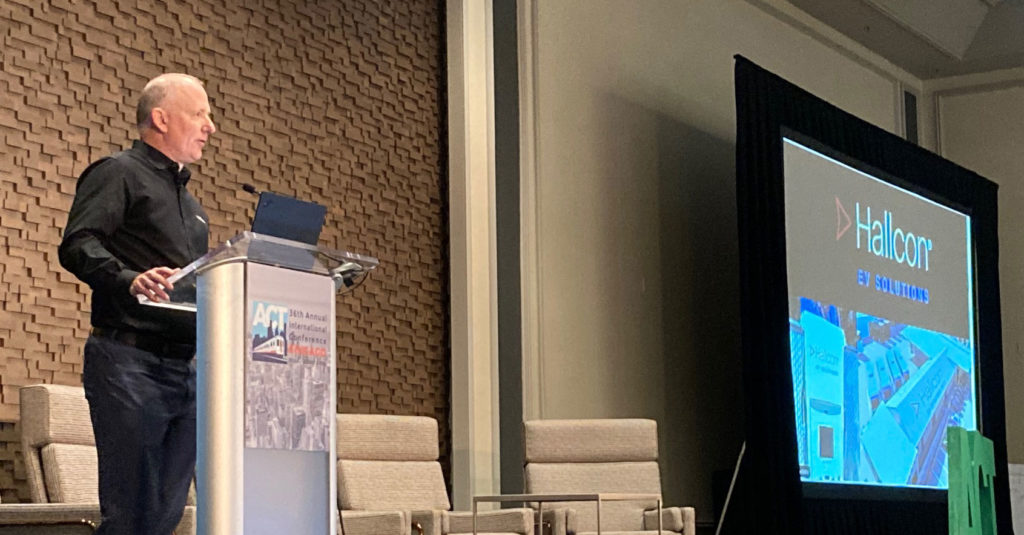On August 2, 2022, Hallcon President & CEO John R. Stoiber addressed attendees of the Association for Commuter Transportation’s (ACT) 2022 International Conference by sharing four critical lessons that every organization needs to know when transitioning to an electrified fleet.
“If you are planning your transition to electric vehicles or are currently in the middle of one, adhering to these four lessons learned will help to ensure a successful and seamless EV transition.”
Stoiber began his remarks by explaining that transitioning to an electric fleet can be complex, requiring diligent preparation and execution to ensure a seamless rollout. Based on Hallcon’s experience engineering EV infrastructure and launching EV fleets, the team has developed learnings that guide the organization’s proprietary EV transition methodology. Stoiber proceeded to share four valuable lessons learned with the ACT audience.
Lesson #1: Infrastructure is Critically Important.
“Getting the vehicles is not the ultimate problem.”
A common misconception many companies make at the onset of an EV transition is being overly concerned with acquiring electric vehicles. Engineering and building out the EV infrastructure needed to support an electric fleet requires extensive planning and precise coordination with multiple partners and production timelines. Considering the following factors will help alleviate any issues that threaten to derail a project when developing EV infrastructure.
- Ensuring that there is ample power on the property
- Anticipating the power required to support the program in 5-7 years
- Setting up duty cycles with the proper charging capacity to manage the transportation program
- Understanding climate and expected weather conditions and the impact on infrastructure and operations.
Proper planning and early acknowledgment of these infrastructure components could save your organization from the impact of costly errors.
Lesson #2: Utility Company Coordination is Crucial
“Working closely with the utility company will ensure all work up to-the-meter is completed.”
Collaboration with local power companies is critical to understanding and acquiring the power required to charge an electric vehicle fleet. This process could take more than a year to complete and includes securing the proper permits and coordinating on To-The-Meter (TTM) gear for additional power.
Working closely with the utility company will also ensure your transformers are sized large enough to accommodate the property. This collaboration may also qualify you for rebate and incentive programs that would otherwise not be available.
Lesson #3: Pay Special Attention to Lead Times
“The one thing that is often forgotten is switch gear”
Preoccupation with lead times for buses and chargers usually takes precedence in an EV transition process. While these challenges do exist, one overlooked component that is equally important is EV equipment like switch gear and controls for charge management.
When determining the vehicles and charging equipment required to manage EV operations it becomes imperative to contact manufacturers to assess lead times on chargers, switch gear, and controls. Certain equipment may need to be custom-built to handle the specific power requirements for your operation.
Lesson #4: Funding is Available to You
“Funding commitments come when you’re still in the planning stage, so make those commitments early.”
While EVs may be more cost-effective to operate over the long term, the initial expenditure required to launch an EV program can be significantly higher.
Many rebate and incentive programs are available for organizations transitioning to electric vehicles. These funding sources are available in multiple states, specifically for those collaborating with their local utility companies. This process requires extensive research, diligence in filling out applications, and early commitments, but the funding will significantly defray fleet electrification costs and is well worth the effort.

Stoiber also gave attendees a glimpse into Hallcon’s exciting new investments in EV infrastructure and technology to support clients when they are ready to transition to electric fleets. These investments include the construction of two major EV Operations Centers in California that will support 200 electric vehicles. One of those properties serves as the organization’s state-of-the-art Sustainable Transportation Center of Excellence, providing training and development and advancing in-house EV expertise.
Hallcon is also in the process of acquiring additional properties throughout the country that will allow the company to expand its base of EV operations to meet client demand.
Held from July 31 to August 3, The ACT Annual International Conference brought hundreds of TDM professionals together from across the globe to share, discuss, and exchange information regarding various transportation solutions and thoughts on improving sustainability initiatives for commuters. The Association for Commuter Transportation (ACT) is a premier organization and leading advocate for commuter transportation and transportation demand Management (TDM) professionals.
Hallcon is deeply committed to supporting our clients as they transition to new sustainable transportation platforms and technologies. For more information on how Hallcon can accelerate your EV transition contact solutions@hallcon.com.
Hallcon was a diamond sponsor of this event and is a proud annual sponsor of the association, partnering in their mission to improve the lives of commuters, the livability of communities, and the economic growth of businesses while providing the best rider experience possible.
